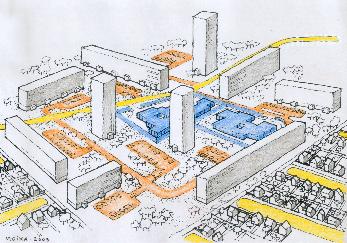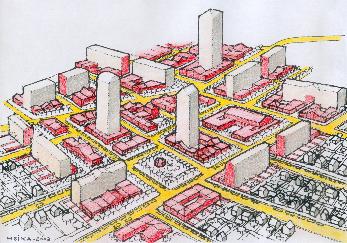|
Urban Infill for sustainability
A
different and quite appropriate form of the Sustainable City
will be achieved by a restructuring of
the housing project estates.
Most
often, these low income "dormitory" estates totally lack social and
functional diversity.
Their
public space is neglected and unsafe, a dead end no man's land..
Joblessness
and a feeling of rejection from mainstream culture and economy leads
the inhabitants of such estates to despair, and sometimes violence and
crime.
Inapropriate
urban forms have a strong effect on people's lives.
Urban
diversity and structure should therefore be introduced, at last,
through an open community planning process, which will consider new
urban grids, with a new local network of streets, avenues, urban
gardens and squares
The
new grid will restructure the no man's land between the housing
buildings, create a defined and flowing public urban space where there
are now only dead end alleys.
That
grid will divide the land into new parcells which will be offered to
investors to build a sequence of low rise buildings for townhouses,
offices, shops, workspaces, services, community halls, etc...
The
estate will gain diversity through concentration, mixture of uses and
of new and old buildings.
The
place of nature will be redefined, from unsafe and neglected lawns and
bushes into neat and well kept urban gardens, and tree lined streets
and avenues.

Before
On
the schematic sketch above of a typical suburban housing project,
the neighbouring suburban sprawl has its grid (in yellow) interrupted.
Similar to thrombosis in the human body, the interruption is brutal and
expresses painful seperation. The local schools, in blue, usually
ground floor mediocre prefabs, are lumped and spread in the center of
gravity of the neighbourhood, as if to further prevent passage and
worsen the thrombosis.
In the schematic sketch below, we attempt to show, in yellow, how the
existing neighbouring streets can be continued, even if we have to
slice through some long slabs, resulting in small blocks throughout.

After
By dividing the no man's land into lots, along the new streets, we can
provide an opportunity for a variety of investors of all sizes to
create a large quantity of new buildings (in red) to house different
uses on affordable land. These new buildings could include offices,
shops, workplaces, service facilities, rebuilt schools, etc..
Mingling new and old buildings will introduce a mixture of uses and the missing diversity.
There will be as many trees as before, or more, but lined along streets and avenues.
Instead of an insecure and sloppy no man's land, we will then have a
defensible urban grid, with safe and well tended urban gardens or
squares.
|

